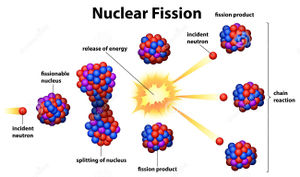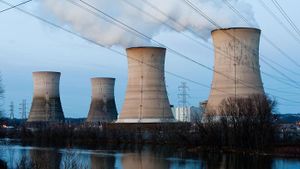Template:Nuclear sustainability
Contents
Nuclear Sustainability
Published: 04/28/2017
Author: Austin Thakur
Topic Editor: Andy Jorgensen
Topic(s):
Nuclear Energy
Sustainability
History of Nuclear Energy
See also: History
The first ideas that all matter is composed of atoms, or indivisible particles, was developed by the Greek philosopher Democritus.
Throughout the 18th and 19th Centuries, different experiments modified the model created by ancient Greek philosophers. The experiments lead to the conclusion that an atom has large amounts of energy. Ernest Rutherford, Albert Einstein, and James Chadwick all performed experiments that helped structure the modern ideas around nuclear energy. Enrico Fermi first created nuclear fission by colliding high-energy neutrons with uranium. German scientists Otto Hahn and Fritz Strassman conducted their own experiments with neutrons.
In 1939, Niels Bohr came to America. He shared with Einstein the Hahn-Strassman-Meitner discoveries. Bohr also met Fermi at a conference on theoretical physics in Washington, D.C. They discussed the possibility of a self-sustaining chain reaction. In such a process, atoms could be split to release high amounts of energy. Eventually, scientists started to believe a self-sustaining chain reaction could be possible if enough uranium, or critical mass, could be brought together under specific conditions.
The first idea for a uranium-fueled chain reactor was proposed by Fermi and Szilard in 1941. In Chicago in late 1942, Fermi and associates combined their theories and began to build the first nuclear reactor. Other scientists were working on breeder reactors which would produce more fissionable material than needed as a result of the chain reaction.
The main goal of nuclear research in the 1950s was to exemplify how nuclear reactors could produce electricity commercially. The first electricity-generating commercial plant powered by nuclear energy was located in Shippingport, Pennsylvania. It was a light-water reactor, it used ordinary water to cool the reactor core during the chain reaction and it obtained its full power output in 1957.
The International Atomic Energy Agency (IAEA) was created by the United Nations (UN) in 1957. It was created to act as an auditor of world nuclear safety. Following Chernobyl, the importance of its role increased. It gives safety procedures and acts as the reporting center for any issues even those related to minor incidents. Every country that uses nuclear power plants to produce electricity has a nuclear safety inspectorate and all of these work closely with the IAEA.
Environmental Effects
See Also: Environmental Impacts
Air Pollution and Greenhouse Gases
Nuclear reactors do not produce air pollution or carbon dioxide while operating like fossil fuel powered plant. Unlike fossil fuel-fired power plants, nuclear reactors do not produce air pollution or carbon dioxide while operating. The production of a nuclear power plant does require large amounts of energy. If that energy is produced using fossil fuels, then the emissions can be identified as greenhouse gas emissions with regards to nuclear energy. The main energy alternatives, coal, petroleum or natural gas in conventional power plants used for electricity generation from fossil fuels are responsible for a 41% of U.S. man-made carbon dioxide emissions. When examining the life cycle analysis, nuclear energy’s greenhouse gas emissions are less than both wind and solar photovoltaic. 7 to 124 grams of carbon dioxide-equivalents and 13 to 731 grams of carbon dioxide-equivalents respectively.
Waste
Waste remains the main environmental concern for nuclear energy. The waste produced by the reactions can be uranium mill tailings, spent reactor fuel, and other radioactive wastes. These materials are harmful because they can maintain harmful levels of radiation for thousands of years. Thus, they are subject to strict regulations for waste transportation, storage, and disposal. The waste can be divided into two categories, low-level and high-level. High-level waste consists of spent, or used, uranium fuel that is no longer efficient in producing power for the reactor and electricity. Low-level waste is the radioactive wastes produced other than high-level and wastes from uranium recovery operation. The waste can be stored in near-surface storage facilities, unlike high-level waste which needs to be stored in underground geologic repositories. Both types of waste can undergo reprocessing where the spent nuclear reactor fuel is separated into material that may be used again, or fissionable, and material that would be disposed of as waste. Reprocessing separates remaining uranium and plutonium that did not undergo fission from the fission products. Both can be used again as fuel for future reactions.
Environmental Sustainability
Nuclear energy is presently an environmentally sustainable source of energy. Although the minute amounts of greenhouse gas emissions released only during the building of the nuclear reactor mean that nuclear energy production is a nearly clean energy source. Not only is nuclear energy almost entirely clean, fuel can be used for a minimum of twelve months.
The environmental impact of the waste can be kept to a minimum by proper storage. Although nuclear energy is not renewable, it is able to be reprocessed. Old waste can be processed and reusable fuel, or fissionable fuel, can be extracted from the spent fuel. This means that the amount of mining to obtain the fuel can be kept to a bare minimum. Limited mining means limited landscape destruction.
Economic Sustainability
Currently, nuclear energy is not cost-competitive with other fossil fuel sources such as natural gas or renewable sources like solar or wind energy. In order to encourage the usage of nuclear energy, subsidies could be provided to companies choosing to use nuclear energy. These subsidies, or “carbon credits”, would be provided to help keep the nuclear reactors running financially because the usage of nuclear energy prevents the emission of greenhouse gases. Although nuclear energy is expensive, it is an investment in the future. The start-up costs dwarf the maintenance costs the environmental benefits justify the high cost.
The Future of Nuclear Sustainability
The future of nuclear energy is in the hands of people. Radioactive waste can be transported, processed, reprocessed, and stored properly. The environmental effects are negligible and the long-term benefits outweigh the short term costs and environmental impact.
References and Further Readings
Administration, E., Energy, D., Commission, U., Service, C., & Association, W. (2015). Nuclear power. Retrieved from http://editors.eol.org/eoearth/wiki/Nuclear_power_(About_the_EoE)
Egan, Kevin. “Economics of Nuclear Energy”. University of Toledo, Toledo. 4/27/2017. Informal Lecture.
Further Reading
http://www.world-nuclear.org/information-library/energy-and-the-environment/sustainable-energy.aspx
https://www.nei.org/Issues-Policy/Protecting-the-Environment/Sustainable-Development
http://www.springsustainability.org/
Citation
Thakur, A. (2017, May 4). Nuclear Sustainability. Retrieved from Nuclear sustainability?veaction=edit

